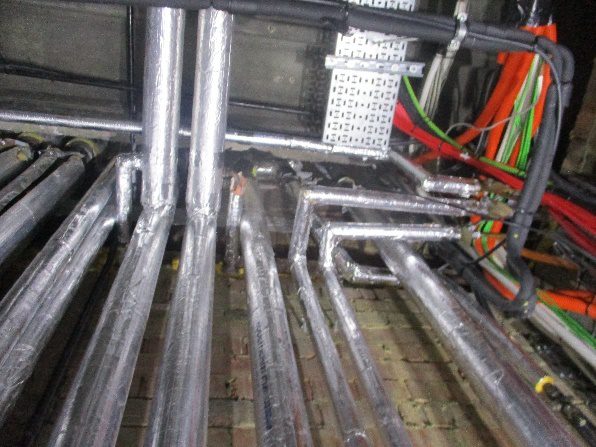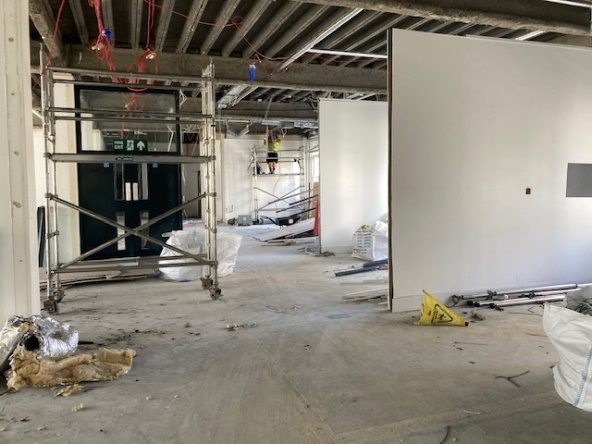Moulsecoomb Campus,
Lewes Road, Brighton BN2 4NT
CONTRACT COMPLETION DATE 16th September 2022
Enabling Works for the Refurbishment of Mithras House at University of Brighton, Moulsecoomb Campus, Lewes Road, Brighton BN2 4NT
Mithras House is undergoing changes to provide a better environment for students to live, learn and socialise in, and support the university’s net zero carbon ambitions. The first and also part of the second floor of the building is being redesigned in readiness for the arrival of the School of Humanities and Social Science from autumn 2023.
External view of Mithras House – front and rear (May 2022)


Internal view of Mithras House – typical corridor and lecture room spaces (May 2022)


What will it look like?
https://www.brighton.ac.uk/accommodation-and-locations/campuses/moulsecoomb/mithras-2023.aspx (Credit to Burrell Foley Fischer Architects And Urban Designers)

The proposed Hellerup staircase will be a main feature of the development and will link the first and second floors of the building, providing an impressive shared space which can be used for lectures, events and as an informal learning and meeting space. Widened corridors and new glass partitions will open up the building throughout, providing light and airy spaces to meet and work.
The enabling works package comprised stripping back and removal of most non-structural elements leaving only the structural shell to the first and part of the second floor. The ground floor, remaining part of the second floor, and third and fourth floors remained in occupancy during the enabling works programme. Access to all floors and fire escape routes was maintained for the duration of the enabling works.
Dorton Group secured this contract through competitive tendering. Briefly, the scope of works comprised:
1. Stripping out redundant furniture, fittings and equipment.



2. Soft strip including floor coverings and suspended ceiling system.


3. Removal of asbestos contaminated materials. Asbestos insulation board was used as a fire stop between floors and walls of two service risers – one adjacent to the central core stairwell and lift shaft and the other next to the northern wing stairwell. All health and safety obligations were strictly adhered to in the completion of this aspect of the work.
Central core riser


North wing riser


4. Dismantling internal non-load bearing walls.



5. Dismantling fixed seating and raised floors to lecture theatres.


6. Stripping out building services – sanitary, water and disposal installations, services equipment, space heating and air conditioning, ventilation, electrical installations, fire protection and firefighting systems, communications, security and control systems, and specialist installations.




7. Provision of rubble and rubbish chutes.




8. Segregation of waste arisings




Typical internal view of the first and second floor of Mithras House on completion of the enabling works (September 2022)


There were many challenges to overcome as summarised below:
1. Mithras House was built in 1939 as an administrative and design office for the Allen West electrical engineering company. It was sold in 1968 during a period of retrenchment; then bought by a property company in 1972; and sold again to East Sussex County Council, who passed it on to Brighton Polytechnic which is now the University of Brighton. Over the past 80+ years, major renovations and retrofits of building services have taken place and the existing ceiling voids were left crammed with redundant pipework and cables. Dde had to ensure that services designated to be stripped did not supply or transit from and to any live areas of the building. Utmost care was also to be taken to avoid disturbing fire compartmentation of escape routes.




2. The fire alarm system was to be maintained and operational during the enabling works ensuring fire protection throughout the building.




3. The licensed asbestos removal work consisted of several complexities:
i. Mithras House servers shared rooms with the central core riser on the second and third floors.

ii. The risers were not a straight vertical run from ground to fourth floor. The central core riser’s base was horizontal at ground floor ceiling height level from an adjacent seminar room. The top of the riser then changed direction again on the fourth floor. The north wing riser changed direction at second floor ceiling height level horizontally into an adjacent female toilet and then continued vertically into a self contained cupboard on the third floor.




iii. Some riser rooms were very constrained in terms of working space and were surrounded by a large network of live services and equipment.


The licensed work involved stripping the asbestos fire stop between floors and walls to all levels of the two riser runs. Mithras House was to be closed to the public for two working days Monday to Tuesday for maintenance works. Dde arranged for a Friday closure to undertake the work over the weekend through to Tuesday. Boilers, power and servers were shut down enabling the works to be undertaken safely and under comfortable working conditions.
Photos on completion of the licensed work






4. Some retained partition walls were unstable following dismantling of adjoining walls and services above. An instruction was given to dismantle these unstable walls within the original contract period.


5. Additional rooms on the second floor were instructed following a design revision. This was to be contained within the original contract programme. Students returned to the university on 19th September 2022 and early completion was key for the university.
Open communication was maintained at all times. The project was delivered safely, with no incidents or injuries recorded, within programme and on budget.
The total tonnage of demolition waste produced was:
- Plasterboard for recycling: 3.25 tonnes
- Rubbish to waste transfer station: 59 tonnes
- Timber recycling: 14.40 tonnes
- Metal scrap for recycling: 40.10 tonnes
- Other miscellaneous items – fridges/ freezers, computers, TV monitors, fluorescent tubes: 1.10 tonnes
- Asbestos contaminated materials to Landfill: 350kg.
In total, 118.20 tonnes of demolition waste was produced of which we were able to recycle 117.90 tonnes.
The waste comprised; rubbish sent to a waste transfer station, recyclable plasterboard, timber, metal and miscellaneous items e.g. fridges/ freezers, computers, TV monitors and fluorescent tubes. Asbestos contaminated materials were sent to an accredited landfill site for disposal.